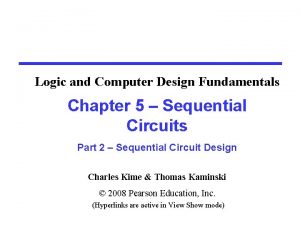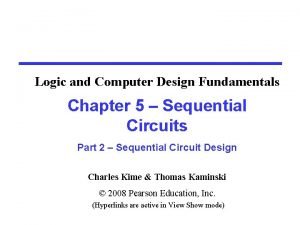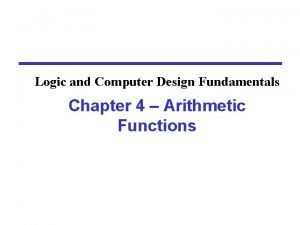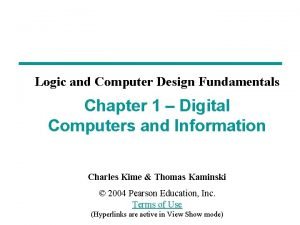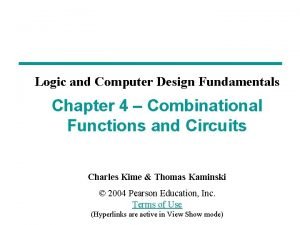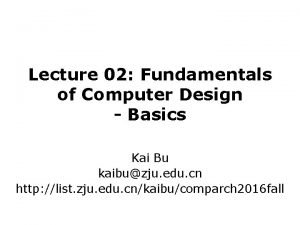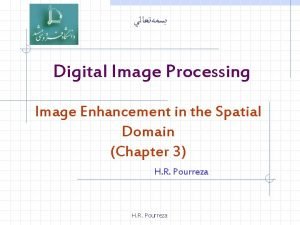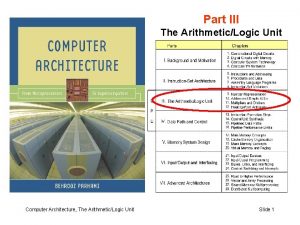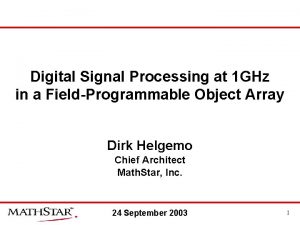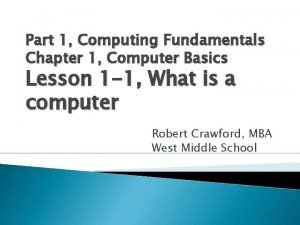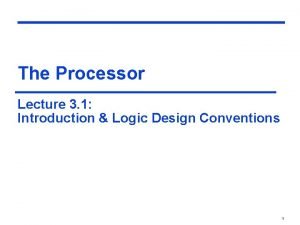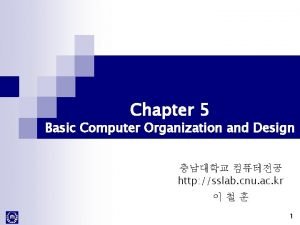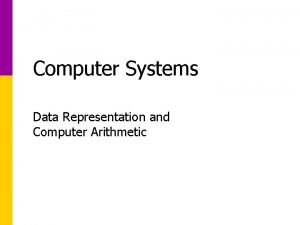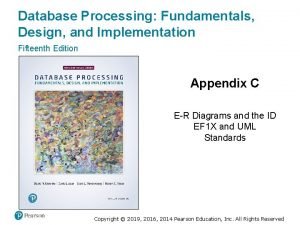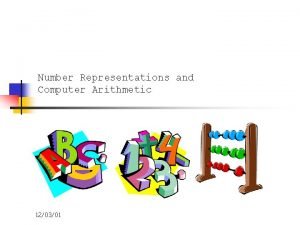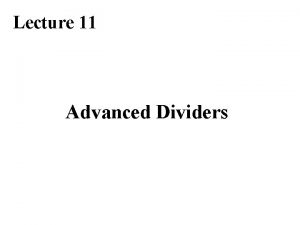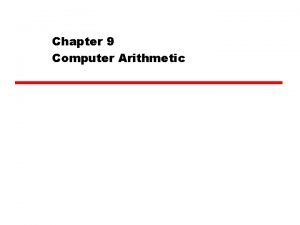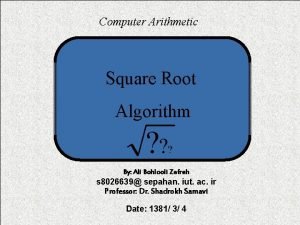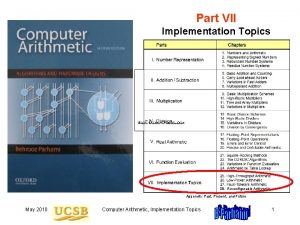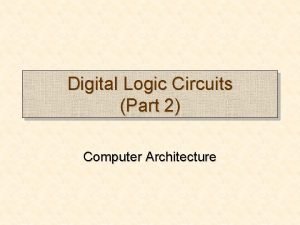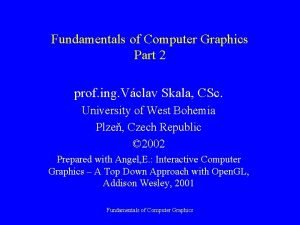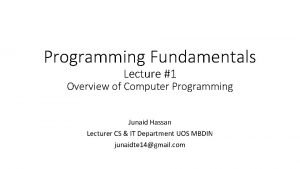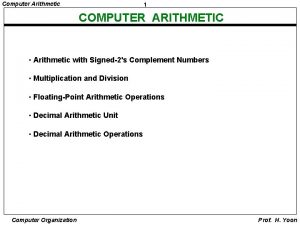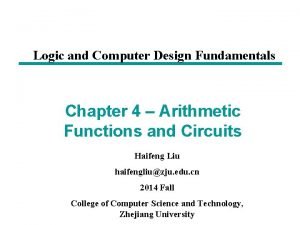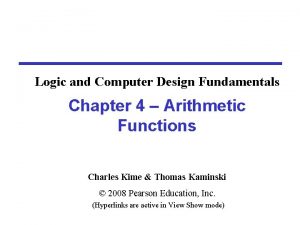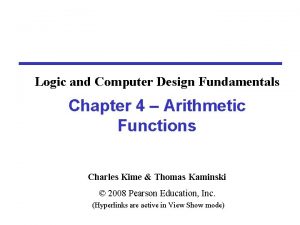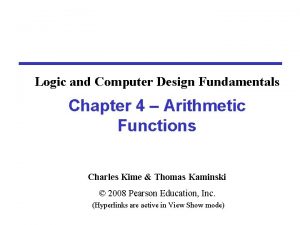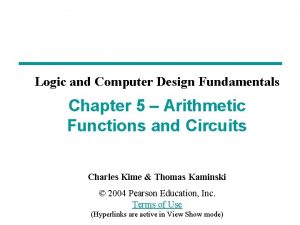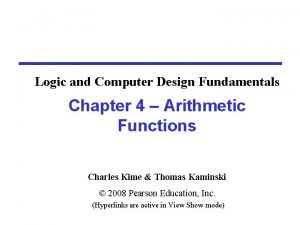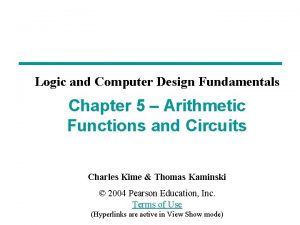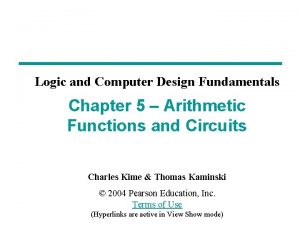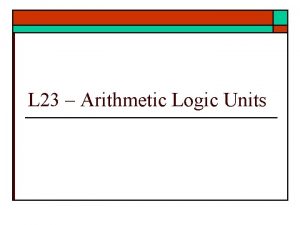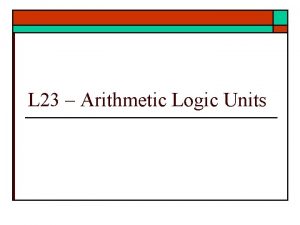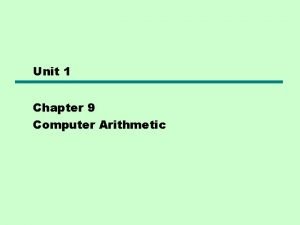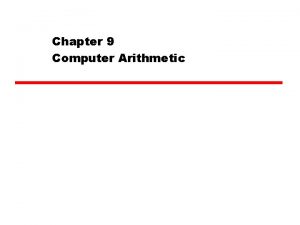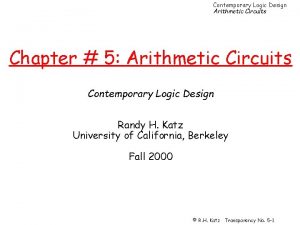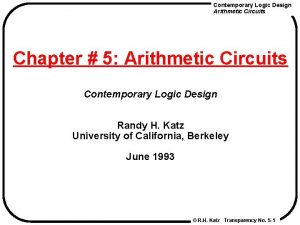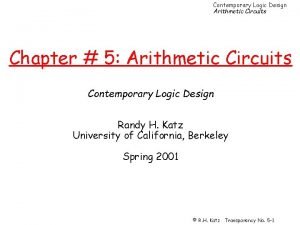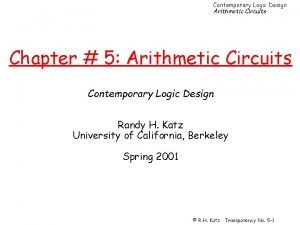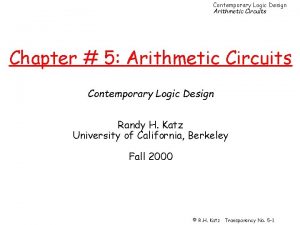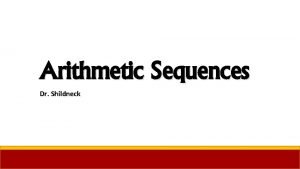Logic and Computer Design Fundamentals Chapter 4 Arithmetic








































- Slides: 40

Logic and Computer Design Fundamentals Chapter 4 – Arithmetic Functions and HDLs

Overview § 4 -1 Iterative combinational circuits § 4 -2 Binary adders • Half and full adders • Ripple carry and carry lookahead adders § 4 -3 Binary subtraction § 4 -4 Binary adder-subtractors • Signed binary numbers • Signed binary addition and subtraction • Overflow § 4 -5 Other arithmetic functions • Design by contraction § 4 -6 Hardware Description language 2

4 -1 Iterative Combinational Circuits § Arithmetic functions • Operate on binary vectors • Use the same subfunction in each bit position § Can design functional block for subfunction and repeat to obtain functional block for overall function § Cell - subfunction block § Iterative array - a array of interconnected cells § An iterative array can be in a single dimension (1 D) or multiple dimensions 3

Block Diagram of a 1 D Iterative Array § Example (didn’t use iteration design): Design a n = 32 bits adder directly • • • Number of inputs = ? Truth table rows = ? Equations with up to ? input variables Equations with huge number of terms Design impractical! § Iterative array takes advantage of the regularity to make design feasible 4

4 -2 Binary Adders § Binary addition used frequently § Addition Development: • Half-Adder (HA), a 2 -input bit-wise addition functional block, • Full-Adder (FA), a 3 -input bit-wise addition functional block, § Ripple Carry Adder, an iterative array to perform binary addition, and § Carry-Look-Ahead Adder (CLA), a hierarchical structure to improve performance. 5

Functional Block: Half-Adder § A 2 -input, 1 -bit width binary adder that performs the following computations: X +Y 0 +0 0 +1 1 +0 1 +1 CS 00 01 01 10 § A half adder adds two bits to produce a two-bit sum § The sum is expressed as a X Y sum bit , S and a carry bit, C 0 0 § The half adder can be specified 0 1 as a truth table for S and C 1 0 1 1 C S 0 0 0 1 1 0 6

Implementations: Half-Adder § The most common half adder implementation is: S = X Y C = XY X Y S C 7

Functional Block: Full-Adder § A full adder is similar to a half adder, but includes a carry-in bit from lower stages. Like the half-adder, it computes a sum bit, S and a carry bit, C. Z 0 0 0 • For a carry-in (Z) of X 0 0 1 0, it is the same as the half-adder: +Y +0 +1 +0 CS 00 01 01 • For a carry- in Z 1 1 1 (Z) of 1: X 0 0 1 +Y +0 +1 +0 CS 01 10 10 8 0 1 +1 10 1 1 +1 11

Logic Optimization: Full-Adder § Full-Adder Truth Table: § Full-Adder K-Map: 9

Equations: Full-Adder § From the K-Map, we get: S = XYZ+ XYZ C = XY+XZ+YZ § The S function is the three-bit XOR function (Odd Function): S = X Y Z § The Carry bit C is 1 if both X and Y are 1 (the sum is 2), or if the sum is 1 and a carry-in (Z) occurs. Thus C can be re-written as: C = X Y + ( X Y) Z § The term X·Y is carry generate. § The term X Y is carry propagate. 10

Full Adder Fig. 4 -4 11

4 -bit Ripple-Carry Binary Adder § A four-bit Ripple Carry Adder made from four 1 -bit Full Adders: 12

Binary Adders § To add multiple operands, we “bundle” logical signals together into vectors and use functional blocks that operate on the vectors § Example: 4 -bit ripple carry adder: Adds input vectors A(3: 0) and B(3: 0) to get a sum vector S(3: 0) § Note: carry out of cell i becomes carry in of cell i+1 Description Subscript 3210 Name Carry In 0110 Ci Augend 1011 Ai Addend 0011 Bi Sum 1110 Si Carry out 0011 Ci+1 13

4 -3 Binary Subtraction § Unsigned Subtraction § Algorithm: • Subtract the subtrahend N from the minuend M • If no end borrow occurs, then M ³ N, and the result is a non-negative number and correct. • If an end borrow occurs, the N > M and the difference M N + 2 n is subtracted from 2 n, and a minus sign is appended to the result. § Examples: See page 173 in textbook. 14

Unsigned Subtraction (continued) § The subtraction, 2 n x, is taking the 2’s complement of x § To do both unsigned addition and unsigned subtraction requires: § Quite complex! § Goal: Shared simpler logic for both addition and subtraction § Introduce complements as an approach 15

Complements § Two complements: • Diminished Radix Complement of N § (r 1)’s complement for radix r § 1’s complement for radix 2 § Defined as (rn 1) N • Radix Complement § r’s complement for radix r § 2’s complement in binary § Defined as rn N § Subtraction is done by adding the complement of the subtrahend § If the result is negative, takes its 2’s complement 16

Binary 1's Complement § For r = 2, N = 011100112, n = 8 (8 digits): (rn – 1) = 256 -1 = 25510 or 11112 § The 1's complement of 011100112 is then: 1111 – 01110011 10001100 § Since the 2 n – 1 factor consists of all 1's and since 1 – 0 = 1 and 1 – 1 = 0, the one's complement is obtained by complementing each individual bit (bitwise NOT). 17

Binary 2's Complement § For r = 2, N = 011100112, n = 8 (8 digits), we have: (rn ) = 25610 or 100002 § The 2's complement of 01110011 is then: 10000 – 01110011 10001101 § Note the result is the 1's complement plus 1, a fact that can be used in designing hardware 18

Subtraction with 2’s Complement § For n-digit, unsigned numbers M and N, find M N in base 2: • Add the 2's complement of the subtrahend N to the minuend M: M + (2 n N) = M N + 2 n • If M N, the sum produces end carry rn which is discarded; from above, M N remains. • If M < N, the sum does not produce an end carry and, from above, is equal to 2 n ( N M ), the 2's complement of ( N M ). • To obtain the result (N – M) , take the 2's complement of the sum and place a to its left. 19

Unsigned 2’s Complement Subtraction (Example 4 -2) § Find 10101002 – 10000112 1010100 – 1000011 1 1010100 + 0111101 0010001 § The carry of 1 indicates that no correction of the result is required. 2’s comp 20

Unsigned 2’s Complement Subtraction (Example 4 -2) § Find 10000112 – 10101002 0 1000011 – 1010100 2’s comp + 0101100 1101111 2’s comp – 0010001 § The carry of 0 indicates that a correction of the result is required. § Result = – (0010001) 21

4 -4 Binary Adder-Substractor Figure 4 -7 22

Signed Integers § Positive numbers and zero can be represented by unsigned n-digit, radix r numbers. We need a representation for negative numbers. § To represent a sign (+ or –) we need exactly one more bit of information (1 binary digit gives 21 = 2 elements which is exactly what is needed). § Since computers use binary numbers, by convention, the most significant bit is interpreted as a sign bit: s an– 2 a 2 a 1 a 0 where: s = 0 for Positive numbers s = 1 for Negative numbers and ai = 0 or 1 represent the magnitude in some form. 23

Signed Integer Representations §Signed-Magnitude – here the n – 1 digits are interpreted as a positive magnitude. §Signed-Complement – here the digits are interpreted as the rest of the complement of the number. There are two possibilities here: • Signed 1's Complement § Uses 1's Complement Arithmetic • Signed 2's Complement § Uses 2's Complement Arithmetic 24

Signed Integer Representation Example § r =2, n=3 Number +3 +2 +1 +0 – 1 – 2 – 3 – 4 Sign -Mag. 011 010 001 000 101 110 111 — 1's Comp. 011 010 001 000 111 110 101 100 — 2's Comp. 011 010 001 000 — 111 110 101 100 25

Signed 2 s complement is mainly used 4 -bits binary signed numbers 26

Signed-Complement Arithmetic § Addition: 1. Add the numbers including the sign bits, discarding a carry out of the sign bits (2's Complement), or using an end-around carry (1's Complement). 2. If the sign bits were the same for both numbers and the sign of the result is different, an overflow has occurred. 3. The sign of the result is computed in step 1. § Subtraction: Form the complement of the number you are subtracting and follow the rules for addition. 27

Signed 2’s Complement Examples § See Example 4 -3 and 4 -4 in Page 181 and 182 of textbook, respectively. 28

Overflow Detection (See P. 184, textbook) § Overflow occurs if n + 1 bits are required to contain the result from an n-bit addition or subtraction § Overflow can occur for: • Addition of two operands with the same sign • Subtraction of operands with different signs § Signed number overflow cases : Carries 0 1 +70 0 1000110 +80 0 1010000 --------------+150 1 0010110 Carries 1 0 -70 1 0111010 -80 1 0110000 ---------------150 0 1101010 29

Overflow Detection § Simplest way to implement overflow V = Cn + Cn 1 30

4 -5 Other Arithmetic Functions § Convenient to design the functional blocks by contraction - removal of redundancy from circuit to which input fixing has been applied § Functions • Incrementing • Decrementing • Multiplication by Constant • Division by Constant • Zero Fill and Extension 31

Design by Contraction § Contraction is a technique for simplifying the logic in a functional block to implement a different function • The new function must be realizable from the original function by applying rudimentary functions to its inputs • After application of 0 s and 1 s, equations or the logic diagram are simplified by using rules given on pages 186 of the text. 32

Design by Contraction Example § Contraction of a ripple carry adder to incrementer (A+1) for n=3 • Set B = 001 Fig. 4 -9 • The middle cell can be repeated to make an incrementer with n > 3. 33

Incrementing & Decrementing § Incrementing • • Adding a fixed value to an arithmetic variable Fixed value is often 1, called counting (up) Examples: A + 1, B + 4 Functional block is called incrementer § Decrementing • • Subtracting a fixed value from an arithmetic variable Fixed value is often 1, called counting (down) Examples: A 1, B 4 Functional block is called decrementer 34

Example 4 -6 § Design a decrementer A-1. • For single bit addition by using a FA with • Perform 35

Multiplication by a Constant (Multiplication of B(3: 0) by 101) 36

Multiplication/Division by 2 n § (a) Multiplication by 100 • Shift left by 2 C 5 § (b) Division by 100 • Shift right by 2 • Remainder preserved B 3 C 4 B 2 C 3 B 2 0 0 C 3 C 2 (a) C 2 B 1 B 0 C 1 C 0 B 1 B 0 0 0 C 1 C 0 C -1 (b) 37 C -2

Zero Fill § Zero fill - filling an m-bit operand with 0 s to become an n-bit operand with n > m § Filling usually is applied to the MSB end of the operand, but can also be done on the LSB end § Example: 11110101 filled to 16 bits • MSB end: 000011110101 • LSB end: 111101010000 38

Extension § Extension - increase in the number of bits at the MSB end of an operand by using a complement representation • Copies the MSB of the operand into the new positions • Positive operand example: 01110101 extended to 16 bits: 000001110101 • Negative operand example: 11110101 extended to 16 bits: 1111110101 39

4 -6 Hardware Description language § We will learn HDL some days in the future. It is neglect at this moment. 40
 Logic and computer design fundamentals
Logic and computer design fundamentals Logic and computer design fundamentals
Logic and computer design fundamentals Logic and computer design fundamentals
Logic and computer design fundamentals Logic and computer design fundamentals
Logic and computer design fundamentals Logic & computer design fundamentals
Logic & computer design fundamentals Microprogram sequencer for a control memory
Microprogram sequencer for a control memory Fundamentals of computer design
Fundamentals of computer design Fundamentals of computer design
Fundamentals of computer design Mask mode radiography
Mask mode radiography The control unit of cpu
The control unit of cpu Arithmetic logic unit
Arithmetic logic unit Computer fundamentals chapter 1
Computer fundamentals chapter 1 Chapter 23 computer system fundamentals
Chapter 23 computer system fundamentals Lllqq
Lllqq Bsa in computer architecture
Bsa in computer architecture Computer arithmetic: algorithms and hardware designs
Computer arithmetic: algorithms and hardware designs Data representation and computer arithmetic
Data representation and computer arithmetic First order logic vs propositional logic
First order logic vs propositional logic First order logic vs propositional logic
First order logic vs propositional logic First order logic vs propositional logic
First order logic vs propositional logic Concurrent vs sequential
Concurrent vs sequential Tw
Tw Software development plan
Software development plan Is it x y or y x
Is it x y or y x Combinational logic sequential logic 차이
Combinational logic sequential logic 차이 Logic chapter three
Logic chapter three Pearson physics
Pearson physics Computer arithmetic
Computer arithmetic Behrooz parhami computer arithmetic
Behrooz parhami computer arithmetic 10000000/215
10000000/215 Arithmetic square root
Arithmetic square root Computer organization and architecture stallings
Computer organization and architecture stallings Computer arithmetic
Computer arithmetic Register in computer organization
Register in computer organization Digital logic and computer architecture
Digital logic and computer architecture Fundamentals of computer graphics
Fundamentals of computer graphics Fundamentals of computer graphics
Fundamentals of computer graphics Computer fundamentals anita goel
Computer fundamentals anita goel Computer security fundamentals 4th edition
Computer security fundamentals 4th edition Programming fundamentals 1
Programming fundamentals 1 Ec 6009
Ec 6009
